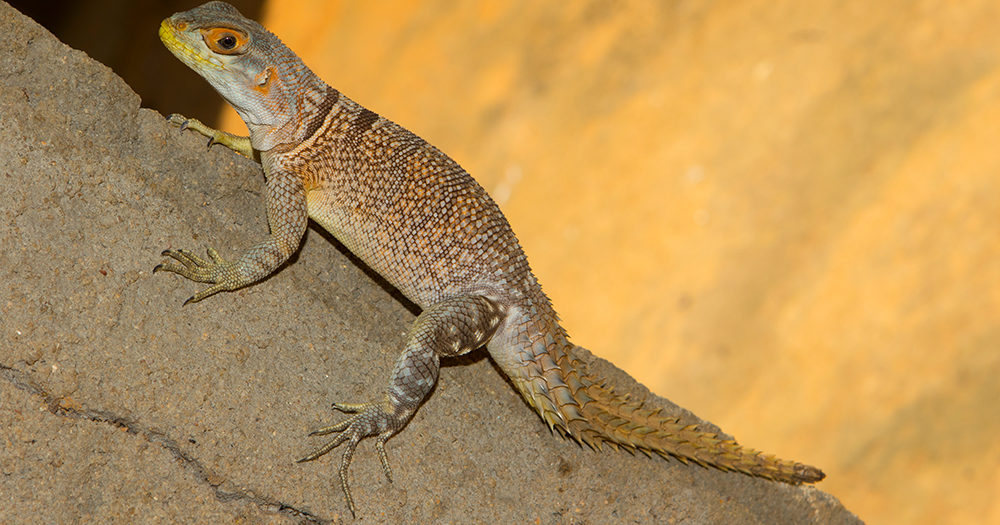It actually isn’t really big, but at least clearly the biggest in its family: The big Cuvier’s Madagascar Swift (Oplurus cuvieri) measures a maximum of 38 cm from the nose to the tip of the tail. Alone the scaly tail constitutes good 20 cm of it. Cuvier’s Madagascar Swift belongs to the family of the Madagascar iguana, that there is only on the red island. The species lives in above all the dry west and northwest of Madagascar. Their habitat is dry forests. Here and there they have adapted to secondary vegetation and savannahs, but trees are clearly preferred. Oplurus cuvieri is the only Madagascar iguana found on Grande Comore, the largest island of the Comoros. However, this is probably a subspecies of its own, as genetic studies show.

Actually, the French naturalist Georges Baron de Cuvier had described the Madagascar Swift as Oplurus torquatus as early as 1829. Two years later the English zoologist John Gray named the species Tropidurus cuvieri and thought it was a different species – in the end the current name of the species has become a mixture of the two.
In many places another Madagascar iguana occurs in the same habitat: Oplurus cyclurus, the Spiny-tailed iguana. At first sight, the two species resemble each other enormously. But if you look closely, you will see the differences: Oplurus cuvieri has one row of small scales each between the large rows of whorlshells on its tail, Oplurus cyclurus does not.
As the name suggests, Cuvier’s Madagascar Swifts live mainly on thick tree trunks. They also come to the ground in search of food, but usually act as attentive lurkers. A wide span is eaten at insects, spiders and plant parts. In the short rainy season, there are very special treats with plenty of flowers and fallen fruit, which tree iguanas like to put on their menu. During the much longer dry season, there is little greenery and the insects also lose weight, so that the Cuvier’s Madagascar Swifts are more likely to adapt to ants and other ubiquitous insects during this time. But also centipedes, whose bite can be enormously painful for humans, are eaten by the Cuvier’s Madagascar Swift without any problems. For resting and at night, Cuvier’s Madagascar Swifts like to visit hollow tree trunks and branch cavities. They can spend the night protected in this way and are relatively safe from birds of prey such as sparrowhawks or curious lemurs.

With the onset of the rainy season in October to November, the mating season of the lizards also begins. Mating is quick and can be repeated several times. A few weeks later, the females dig a pit in the sandy soil in which they lay two to five white eggs. Then the hollow is hastily filled up and the female leaves her offspring to her fate, to mate again and produce another clutch. This strategy ensures that as many iguana eggs as possible are buried in the sandy soil. The eggs, which are not buried very deep, are easy prey, especially for snakes like the Madagascar hognosed snake. Young iguanas hatch from the surviving eggs after two months. The small iguanas are self-sufficient from the first day on and go immediately their ways. As adult lizards, the Cuvier’s Madagascar Swifts make use of the warning calls of birds: Paradise flycatchers, that occur in the same habitat, have similar predators. If the warning call of a Paradise Flycatcher sounds through the dry forest, also Cuvier’s Madagascar Swifts become cautious. By the way, Cuvier’s Madagascar Swifts can reach enormous life spans. Some animals in human hands already became over 30 years old.
Madagascar tree iguanas can be observed very well, especially during the rainy season, when they are most active. In the reserve Kirindy and the national parks Ankarafantsika, Zombitse-Vohibasia and Tsingy de Bemaraha they are common and not shy. Outside of protected areas, they can be found in the Ambanja, Ambilobe, Antsohihy, Itremo, Mahajanga and Miandrivazo areas in forests. Due to its wide distribution in Madagascar, Cuvier’s Madagascar Swift is not considered endangered. It is not under protection, but the population size decreases only little. The lCuvier’s Madagascar Swift will therefore continue to observe travellers from trees for many years to come – and vice versa.

 MADAMAGAZINE Your Magazine about Madagascar
MADAMAGAZINE Your Magazine about Madagascar









